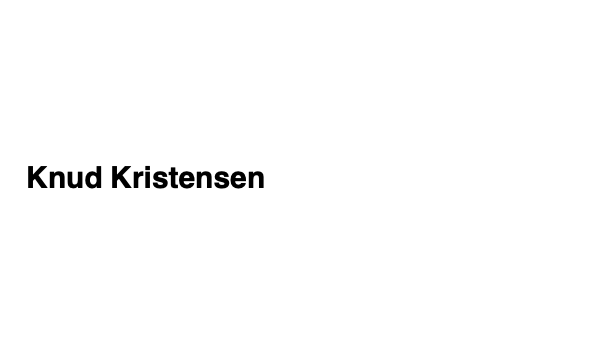
Knud Kristensen served as the Prime Minister of Denmark from 7 November 1945 to 13 November 1947. He led the first elected government in the country after World War II ended. In his capacity as prime minister, he made major changes in the way Denmark did business. Kristensen was one of Denmark’s most respected politicians.

Knud Kristensen is not your average farmer. He’s a member of several organizations, including the Danish American Heritage Society, Nordic Heritage Museum, Rebild National Park Society, Harmonien, and the Danish Brotherhood. He also serves on the board of directors of the Northwest Danish Home in Seattle.
Morten is a devout Danish farmer. His youngest son, Anders, shares his father’s religion, but his eldest son Mikkel has lost his faith. Meanwhile, his middle son, Johannes, has become delusional and declares that he is Jesus Christ. Despite the differences in faith, everyone in the family supports each other. Nevertheless, the book’s ending – which is also one of its strengths – will leave readers wondering how this family will ever survive without each other.
Knud Kristensen’s political career began in the early 1920s. He had been a farmer before entering parliament, and studied at Frederiksborg University College from 1901-1902. He later went on to study at the Dalum Agricultural School, and was elected to the Social Democratic Party as minister of the interior in 1923. The next year, he was elected to the parliament, but his first term was short lived.
The second longest-serving prime minister in the history of Denmark, Knud Kristensen served between 1924 and 1932. Born in 1869 in Denmark, he was the son of a primary school teacher. He went on to become a lawyer and was a minister in the Ministry of Justice. His career also included positions at the Supreme Court and the Public Trustee’s Office.
As Prime Minister, Kristensen rekindled the national spirit and brought back national hopes for the re-acquisition of Schleswig. After studying at Frederiksborg University College and Dalum Agricultural School, he entered Parliament in 1922 and served as a Minister of the Interior in the coalition government of Thorvald Stauning. After Stauning’s death, Kristensen resigned and was replaced by Erik Scavenius, who sought accommodation with the Germans.
His cabinet was comprised entirely of social democrats, but he was not popular with the Danish Social Liberal Party, who disapproved of the high military budget because of the country’s NATO obligations. Kristensen resigned as Prime Minister on 30 September 1953, resigning on the spot. However, he was later re-elected in 1958.
During the 1980s, the social-democratic government resigned in the midst of a financial crisis and was replaced by a conservative coalition led by Poul Schluter. Venstre and the Conservative Party forged an alternative liberal movement, describing it as a mixture of ‘numbers and economics’ and ‘philosophy’. The resulting political crisis sparked a nationwide debate on the nature of socialism.
Kristensen was a farmer by profession. His educational background included Frederiksborg University College, Dalum Agricultural School, and Askov Folk High School. He also owned farms at Odsted in Vejle and Biviumgard in Humlebaek. During his time as Prime Minister, he implemented many progressive policies to improve the quality of life.
Kristensen’s relationship to social democracy has a long history. He was raised in the traditional social democratic milieu of Northern Jutland, and his father was a social democratic municipal politician. He remained active in his work for social democracy in Aalborg and Aarhus, where he collaborated with social democratic leaders Poul Nielson and Svend Auken.
He believed in mass work in the workplaces. But it was important that it have a broader political-socialist aim. RS made contacts in unions and gathered a substantial amount of money to support the strikers. RS had many contacts with trade unions, including Knud Ellegaard.
RS sought contact with people likely to become active participants. This was done through the publication of the organ Arbejderpolitik. It later joined the Clarte movement.
Knud Kristensen is a Danish painter. He was born in 1915. His work was greatly influenced by the events of the 1930s, when political ideologies clashed. The Soviet Union needed urgent funds for industrialisation, and the government sold off a vast collection of state art. This collection included 250 Old Master paintings. Some of these paintings were purchased by Andrew Mellon, a wealthy businessman from the United States.
Knud Kristensen is the owner of Kek Consulting. He has fifteen years of experience in the field of business and is considered one of the top entrepreneurs in Denmark. He studied at Frederiksborg University College, Dalum Agricultural School, and Askov Folk High School. After graduating, he worked as a farmer in Vejle. He also owned a farm in Humlebaek called Biviumgard. In addition to his business endeavors, he served as a member of parliament in Denmark from 1932 until his resignation in 1949.
Max Ernst Among the most famous artists of the twentieth century, Max Ernst was a
Angelina Jolie DCMG – An Icon in Hollywood Whether you love her as an actress
Barack Hussein Obama II Barack Hussein Obama II served as the 44th President of the
A Brief Look at Ben Affleck Benjamin Affleck is a well-known American actor and director.
Alicia Keys Alicia Keys is a famous American singer, songwriter and pianist. She was born